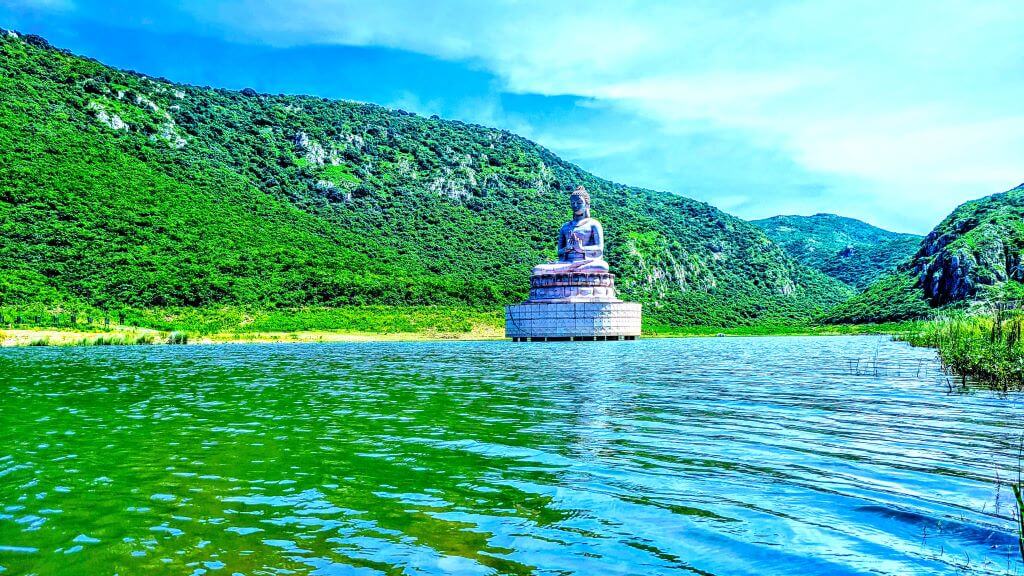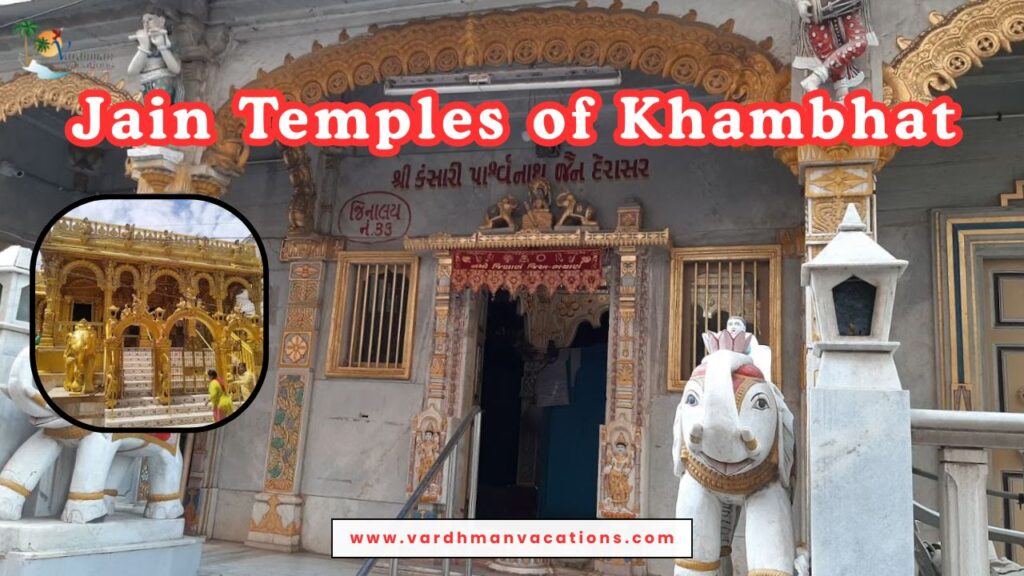Rajgir, located in Bihar, India, is one of the most ancient and spiritually significant cities in the country. Nestled amidst rolling hills and lush valleys, Rajgir has been a center of religion, meditation, and learning for centuries. The city is not only significant in Jainism and Buddhism but also holds a special place in Indian history, dating back to the Magadha kingdom. Whether you are a pilgrim seeking spiritual solace, a history enthusiast fascinated by ancient relics, or a nature lover eager to explore scenic landscapes, Rajgir offers a unique and enriching experience.
In this guide, we take you on a comprehensive journey through Rajgir, covering its major attractions, hills, caves, temples, and natural spots, along with practical travel tips to make your visit memorable.
Spiritual and Historical Attractions in Rajgir
1. Veerayatan
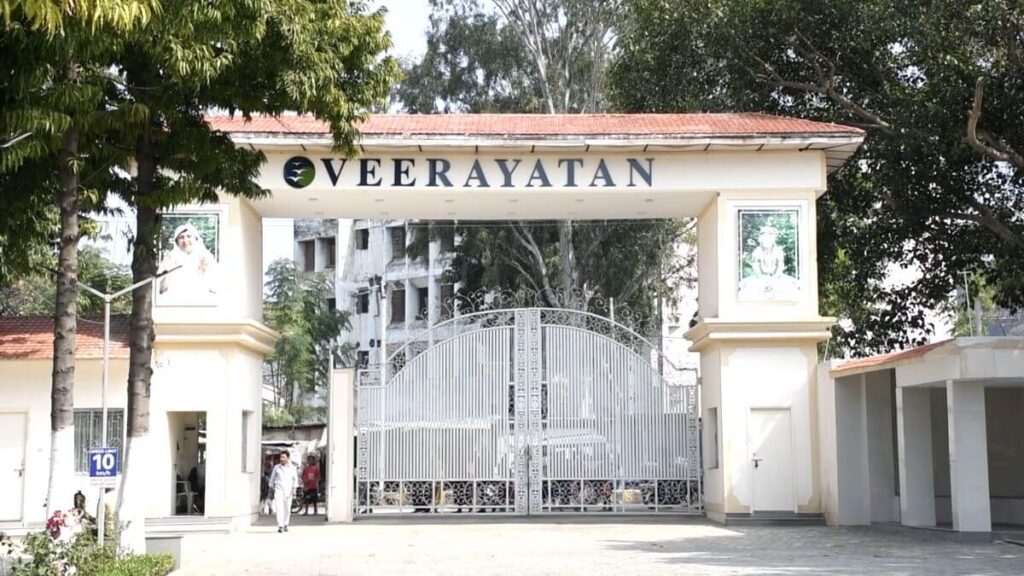
Veerayatan is a sprawling spiritual complex in Rajgir, attracting devotees, scholars, and tourists alike. It is a blend of religious devotion, education, and cultural preservation. The complex is divided into several key sections:
- Shri Brahmi Kala Mandiram (Museum): This museum houses ancient manuscripts, sculptures, and artifacts, offering a glimpse into India’s rich spiritual heritage. The displays here reflect the evolution of art, religion, and culture in the region, particularly during the Maurya and Gupta periods.
- Shri Parsva Jinalaya: A tranquil Jain temple dedicated to Lord Parsvanath, it is a place for meditation and spiritual reflection. Its architecture, adorned with intricate carvings, is a testament to Jain artistry.
- Saptaparni: Known for its serene ambiance, Saptaparni is a meditation site that has been a retreat for saints and spiritual seekers for centuries. The site offers visitors a peaceful environment surrounded by nature.
- Netra Jyoti Seva Mataram: This facility is committed to community service and spiritual learning. It serves as a center for meditation, study, and charitable activities, embodying the principles of selfless service central to Indian spiritual traditions.
2. Japanese Temple
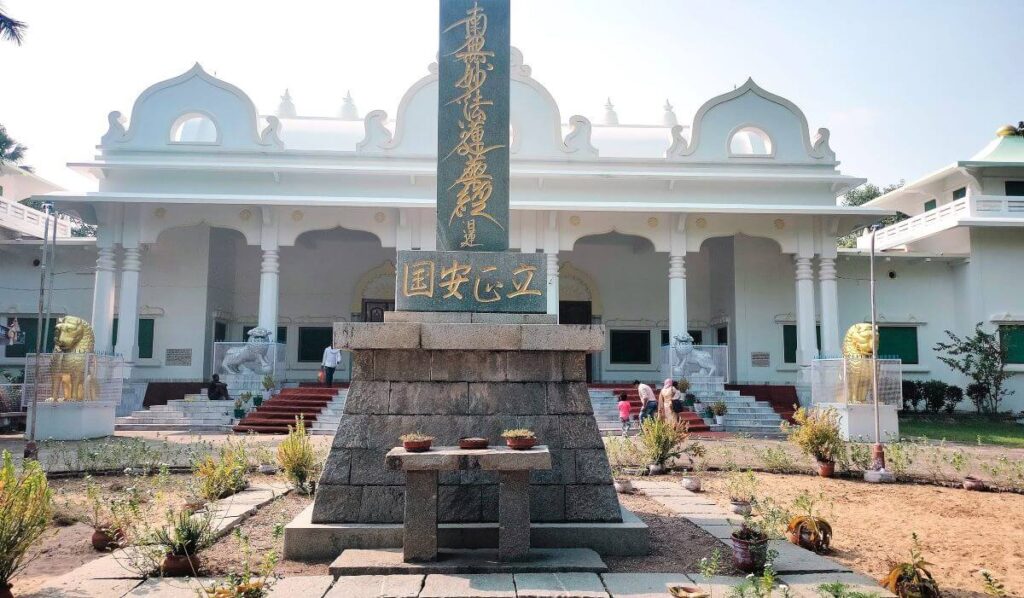
The Japanese Temple in Rajgir, also known as the Shanti Stupa Japanese Temple, is a serene symbol of peace and the enduring cultural bond between India and Japan through Buddhism. Built by the Nipponzan Myohoji Buddhist order, it stands at the base of Ratnagiri Hill surrounded by lush greenery, offering a tranquil retreat for meditation and reflection. The temple embodies the universal message of compassion and harmony taught by Lord Buddha.
Inside the temple, visitors can have darshan of Lord Buddha and his disciple Sariputra, whose statues radiate serenity and wisdom. The interiors are beautifully adorned with murals depicting important events from Buddha’s life, while the rhythmic chanting of monks fills the air with a sense of spiritual calm. The temple’s architecture, blending Japanese simplicity with Indian Buddhist tradition, reflects purity, discipline, and devotion.
The Japanese Temple is not just a place of worship but also a center of peace and mindfulness. Regular prayer sessions, meditation gatherings, and peace ceremonies attract pilgrims from across the world. Many visitors also take the ropeway from the temple to the Vishwa Shanti Stupa above, enjoying panoramic views of Rajgir’s valleys. It is truly a place where spirituality, culture, and nature converge in perfect harmony.
3. Venuvan
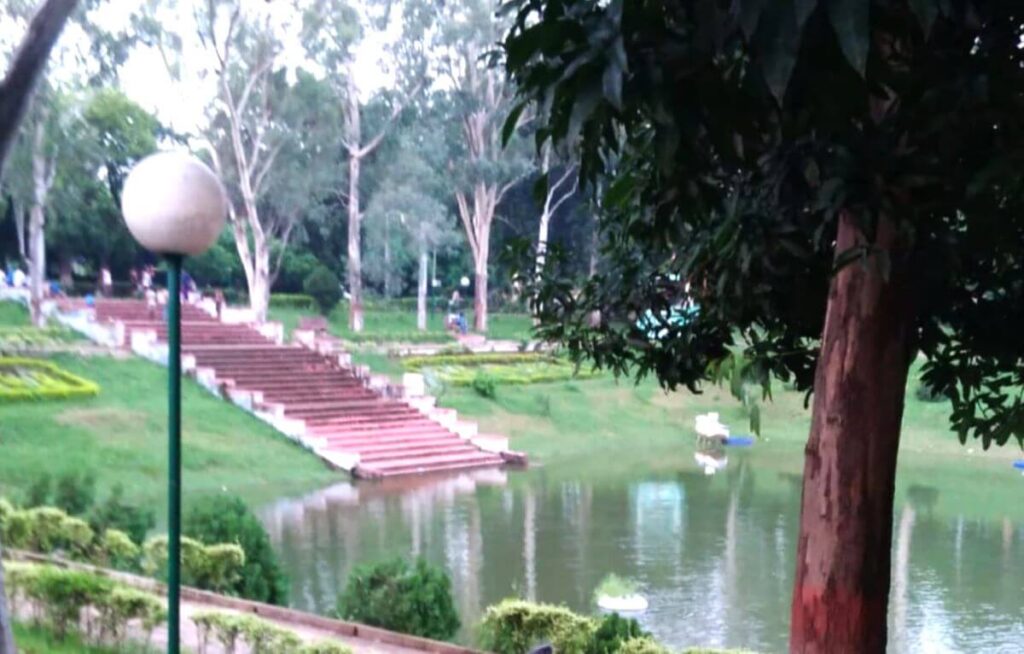
Venuvan is a historic bamboo forest where Lord Buddha once meditated. The forest is a place of natural beauty, peace, and spiritual reflection.
- Lord Buddha’s Place of Penance: Venuvan holds significance as a location where Lord Buddha engaged in deep meditation and penance. Pilgrims often visit this serene spot to follow in his footsteps.
- Karad Talab: A nearby sacred pond, Karad Talab was used by Lord Buddha for ritual bathing. It remains a place of spiritual importance, surrounded by lush greenery.
- Awan: This area of Venuvan, characterized by dense bamboo groves, was reportedly a favorite meditation spot for Lord Buddha. Visitors can walk along the narrow paths, immersing themselves in nature and history.
4. Hot Water Springs and Ponds
Rajgir is well-known for its natural hot water springs, located at the foothills of the first and fifth hills near Vaibharagiri. These springs have been revered for centuries and continue to attract pilgrims and tourists seeking spiritual and physical rejuvenation.
The springs hold spiritual significance as they are mentioned in ancient Buddhist and Jain texts. Saints, monks, and pilgrims historically visited these waters to refresh their bodies and spirits during their journeys, making the site an important center for meditation and devotion.
In addition to their spiritual value, the springs are believed to have health benefits. Rich in minerals, the water is said to help with skin ailments, joint pain, and stress relief. Bathing in these springs is considered both a physical therapy and a spiritually cleansing experience, making it a unique attraction in Rajgir.
5. Pippal Caves and Saptaparni Caves
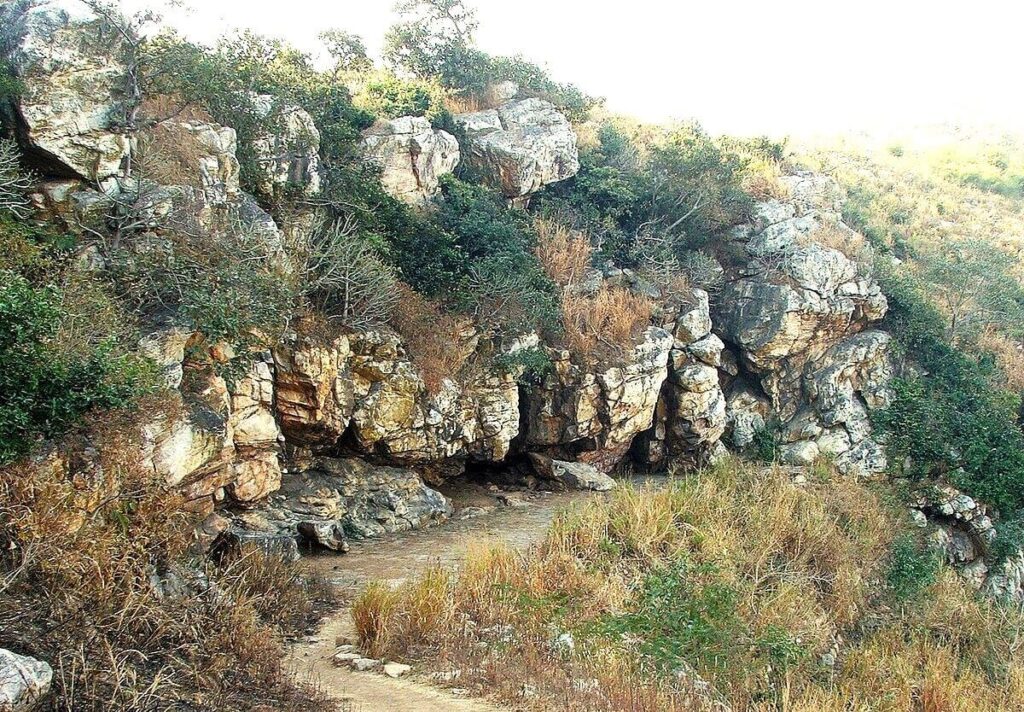
The hills of Rajgir are home to numerous ancient meditation caves, long used by monks and saints for spiritual practice. These caves offer a glimpse into the serene lifestyle of early Buddhist practitioners and the region’s rich religious history.
Pippal Caves: Also known as the Stone House, served as a shelter and meditation space for Buddhist monks. Their simple yet sturdy structure provided a peaceful environment for contemplation and study.
Saptaparni Caves: Located on Vaibharagiri Hill, hold great historical importance. They were the meditation site for saints and the venue of the first Buddhist council, making them a vital location for spiritual reflection. Surrounded by tranquil nature, the caves remain a retreat for devotees and visitors seeking calm and insight.
6. Shwetambar Jain Temple (Navlakha)
The Shwetambar Jain Temple, also known as the Navlakha Temple, is one of the most significant Jain pilgrimage sites in Rajgir. Dedicated to Lord Munisuvrata Swami, the 20th Tirthankara in Jainism, this sacred temple holds immense spiritual importance for followers of the Shwetambar sect. Surrounded by tranquil landscapes and ancient Jain heritage, the temple offers devotees a serene atmosphere ideal for meditation and devotion.
The architectural beauty of the Navlakha Temple is truly remarkable. Built with fine marble and adorned with detailed carvings, the temple stands as a masterpiece of Jain craftsmanship. Its sanctum houses the idol of Lord Munisuvrata Swami, radiating peace and compassion. The temple’s name “Navlakha” is believed to have originated from the nine lakhs (900,000) rupees spent on its construction, symbolizing both devotion and grandeur.
One of the unique aspects of this temple is its association with the Four Kalyanaks — the four major events in a Tirthankara’s life: Chyavan (conception), Janma (birth), Diksha (renunciation), and Moksha (liberation). These sacred celebrations make the Navlakha Temple a vital center for Jain religious study and rituals. Every year, thousands of pilgrims visit to participate in these observances and seek spiritual upliftment, making this temple a shining emblem of Jain faith and heritage in Rajgir.
7. Digambar Jain Temple and Lal Mandir
The Digambar Jain Temple and Lal Mandir, located about 3 kilometers from Rajgir village, are two of the most revered spiritual landmarks for Jain devotees. These temples reflect the region’s deep connection with Jainism and its ancient heritage. Set amidst peaceful surroundings, they offer a calm and meditative atmosphere that attracts pilgrims and travelers seeking both spiritual enlightenment and architectural beauty.
The Digambar Jain Temple is dedicated to the Tirthankaras, particularly Lord Mahavir, who is believed to have meditated in the nearby hills. The temple’s marble idols, intricate carvings, and beautifully designed pillars showcase the elegance of Jain craftsmanship. Just nearby, the Lal Mandir, with its distinctive red façade and serene sanctum, stands as a symbol of devotion and purity. The temple’s vibrant color and detailed artwork make it a striking sight amid Rajgir’s natural landscape.
Both temples play an important role in the Jain pilgrimage circuit of Rajgir. During festivals like Mahavir Jayanti and Paryushan, they become centers of celebration and spiritual reflection. Visitors can meditate, offer prayers, or simply absorb the temple’s peaceful energy while admiring the view of the surrounding hills. Together, the Digambar Jain Temple and Lal Mandir beautifully represent Rajgir’s timeless blend of faith, history, and artistic tradition.
8. Maniyar Math
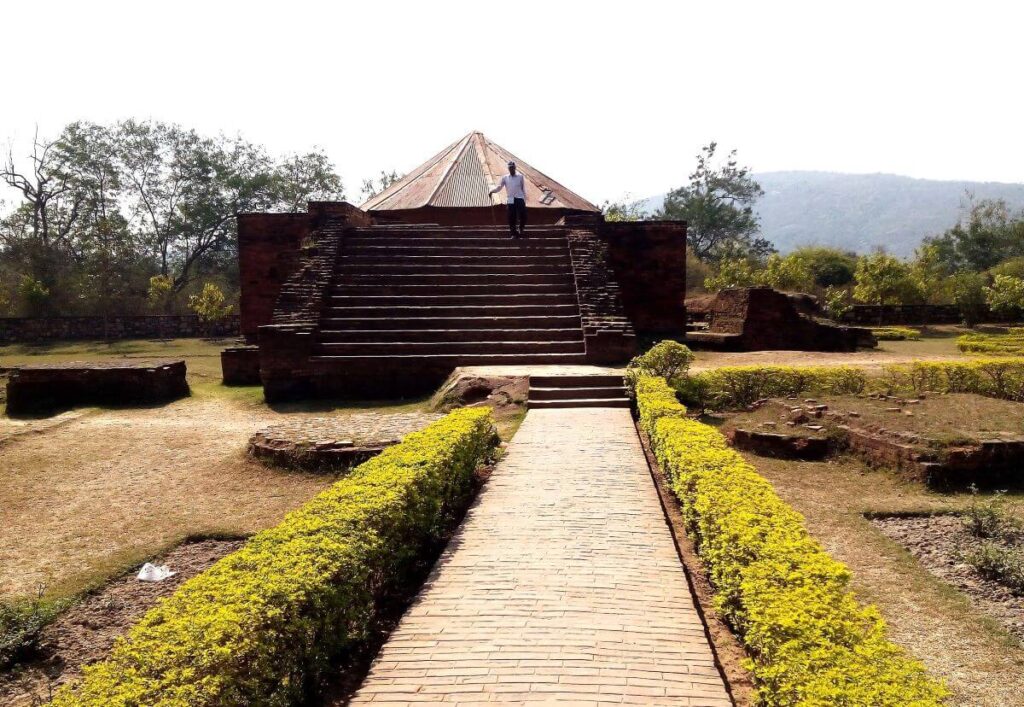
Maniyar Math is an ancient and sacred site in Rajgir, believed to be the abode of the deity Maninaga according to Vedic traditions. This place has been a center of worship for centuries, attracting devotees from different parts of India who come to offer prayers and seek blessings.
The Math is built in a unique circular shape, resembling a stupa. Archaeological discoveries here, including terracotta figures and carvings of serpents, suggest that the site was closely linked to the Naga cult and played an important role in early spiritual practices.
Today, Maniyar Math is both a religious and historical landmark. Visitors can experience a peaceful environment while exploring its rich cultural heritage. Its blend of mythology, architecture, and devotion makes it a special stop for pilgrims and tourists in Rajgir.
9. Sonbhandar (Golden Treasure)
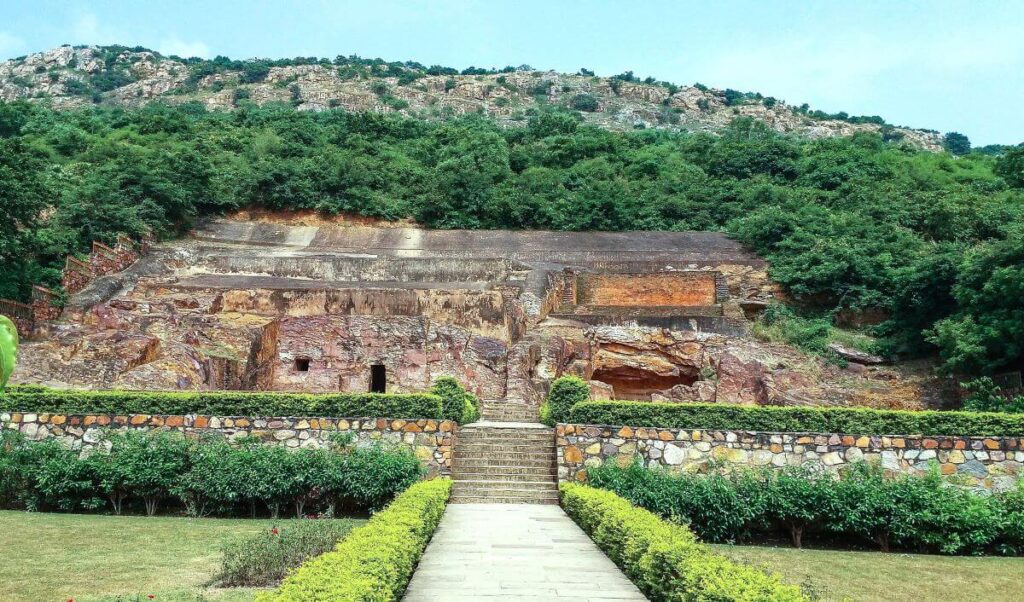
Sonbhandar Cave, also known as the Golden Treasure, is one of Rajgir’s most fascinating historical and religious sites. This ancient rock-cut cave is believed to date back to the Mauryan period and is renowned for its mysterious legend connected to King Shrenik, a devout follower of Lord Mahavira. According to folklore, the king’s vast treasure was hidden inside this cave, sealed by an inscription that has puzzled historians for centuries.
The site was first documented by the British archaeologist Alexander Cunningham, who identified its architectural style and inscriptions as evidence of early Jain influence. The cave’s beautifully polished interior walls and finely carved doorway reflect the artistic brilliance of ancient Indian craftsmanship, adding to its archaeological importance.
Sonbhandar is also a spiritual site for Jain devotees, as the right wall of the cave features carvings of Tirthankaras Padmaprabhu, Parshvanath, and Mahavir Swami. Pilgrims visit to pay homage to these sacred images while marveling at the legends that surround this mystical cave. A visit to Sonbhandar offers a rare combination of history, art, and devotion — making it an unmissable stop in Rajgir.
10. Bimbisara Prison
Bimbisara Prison is a historic site in Rajgir where King Bimbisara of Magadha was imprisoned by his son Ajatashatru. The prison covers about 60 square meters and has 2-meter-wide stone walls, reflecting the strength and simplicity of ancient Magadha architecture.
The prison holds historical significance as it tells the story of political intrigue and family conflict during the Magadha dynasty. Despite being confined, Bimbisara remained devoted to Lord Buddha and continued supporting the spread of Buddhism in the region.
Today, visitors can explore the ancient prison and imagine the events that took place here. Its historical aura and serene surroundings make it an interesting stop for those looking to connect with Rajgir’s royal and spiritual past.
11. Vishwa Shanti Stupa
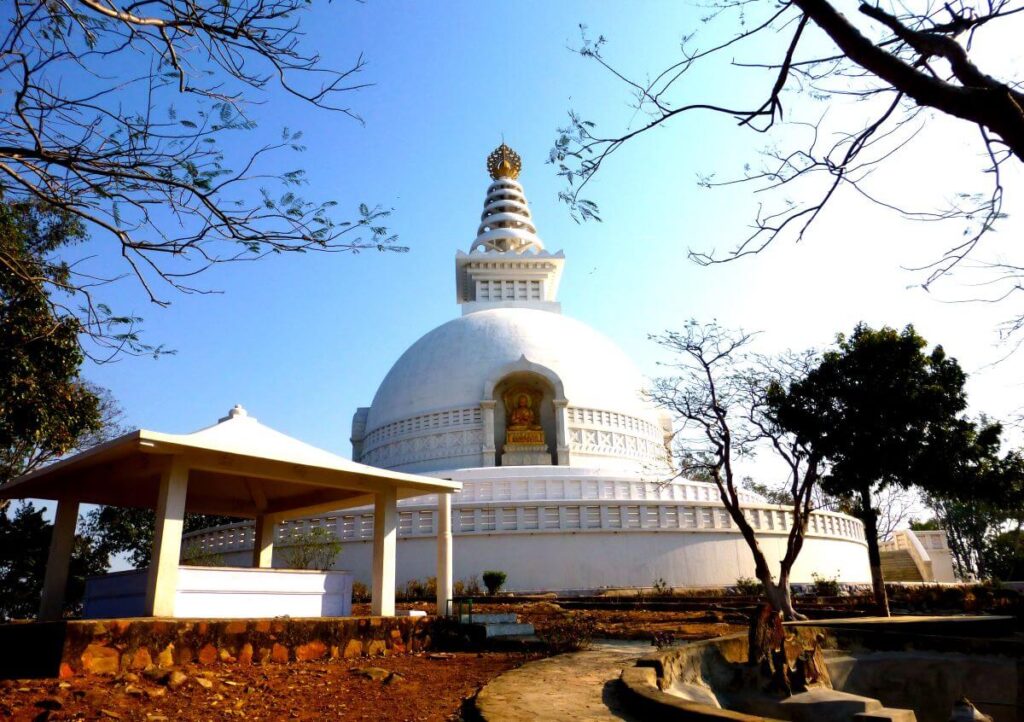
The Vishwa Shanti Stupa, or Peace Pagoda, is a majestic monument located atop Ratnagiri Mountain in Rajgir. Built to promote global peace and harmony, it stands as a symbol of Buddhist philosophy and spiritual unity. The stupa is revered by pilgrims and travelers alike for its serene ambiance and breathtaking location.
Visitors can reach the stupa via a scenic ropeway, which offers panoramic views of Rajgir’s lush hills, valleys, and surrounding landscapes. The journey itself is a memorable experience, giving a bird’s-eye view of the city’s natural beauty and historic sites.
The stupa provides an ideal setting for meditation and reflection, with its peaceful environment enhancing spiritual practices. Pilgrims often spend time here in quiet contemplation, absorbing the tranquility and scenic vistas, making it one of the most inspiring sites to visit in Rajgir.
12. Chariot Wheel Mark

The Chariot Wheel Mark in Rajgir is a fascinating historical and mythological site. According to legend, during the Mahabharata period, Lord Krishna rode his chariot here, leaving engravings on the stone that can still be seen today. This connection to epic history makes it a unique attraction for visitors.
The site offers a glimpse into ancient times, allowing travelers to imagine the events and stories of the Mahabharata unfolding in this very location. The stone markings serve as a tangible link between mythology and history, captivating both devotees and history enthusiasts.
Visiting the Chariot Wheel Mark is a must for those interested in Indian epics and cultural heritage. The peaceful surroundings, coupled with the historical significance, provide an enriching experience that combines spirituality, legend, and the charm of ancient Rajgir.
The Five-Hill Journey of Rajgir
Rajgir’s hills are not only scenic but also deeply rooted in history and spirituality. Trekking these hills is a journey through time and devotion.
- Vipulgiri (565 steps):
- Significance: Lord Mahavir delivered his first sermon here.
- Temples: Lord Putisuvratnathji, Chandraprabhaji, and other revered figures.
- Ratnagiri (1,285 steps):
- Significance: Home to idols of Lord Shantinath and Chandraprabhaji.
- Highlights: Breathtaking views of the surrounding valleys.
- Udayagiri (785 steps):
- Temples: Dedicated to Lord Mahavirji, Shantinathji, and Adinathji.
- Historical Value: Important meditation sites for Jain and Buddhist monks.
- Swarngiri (1,050 steps):
- Temples: Houses Lord Adinath and Mahavir Swami temples.
- Spiritual Experience: A place for peaceful reflection amidst nature.
- Vaibharagiri (565 steps):
- Temples: Lord Adinathji, Munisuvratswamiji, Parshvanathji, Mahavirswamiji, Shalibhadraji.
- Historical Significance: Site of the nirvana of 11 Ganadhars and Saptaparni Cave, where the first Buddhist council was held.
Nature and Wildlife Attractions
13. Rajgir Zoo Safari / Nature Safari
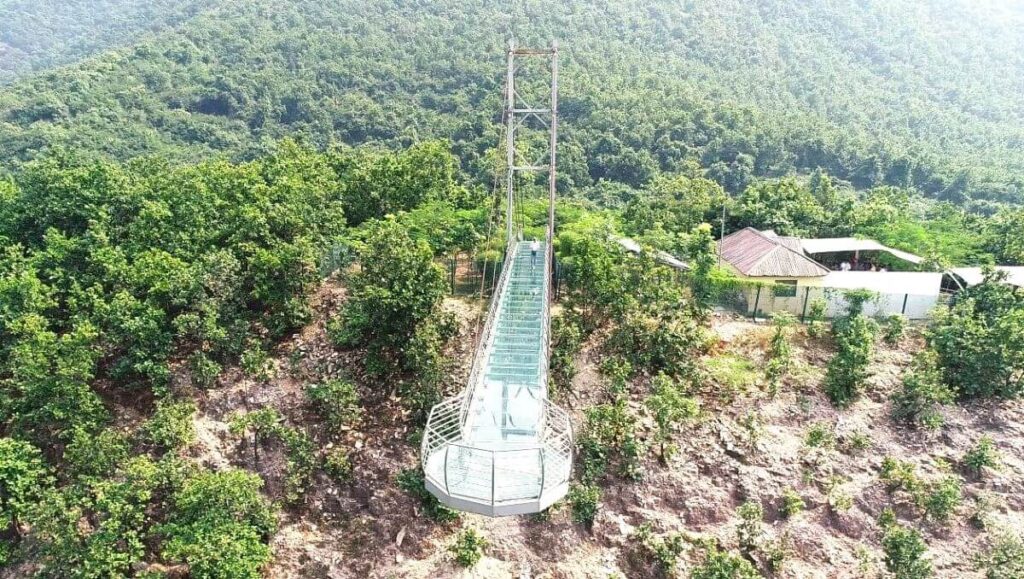
The Rajgir Zoo Safari and Nature Safari offer an exciting experience for wildlife enthusiasts visiting the city. Set amidst lush forests and hills, the safari provides a chance to explore the natural habitat of several native species, making it a popular destination for families and nature lovers.
One of the highlights of the safari is the glass and suspension bridges, which allow visitors to safely observe animals and birds from close proximity. Walking across these bridges gives a thrilling perspective of the surrounding wildlife and landscapes.
Visitors can spot deer, birds, and other native species while enjoying the serene environment. The safari not only provides adventure and recreation but also promotes awareness of wildlife conservation, making it both educational and enjoyable for all ages.
14. Pandupokhar
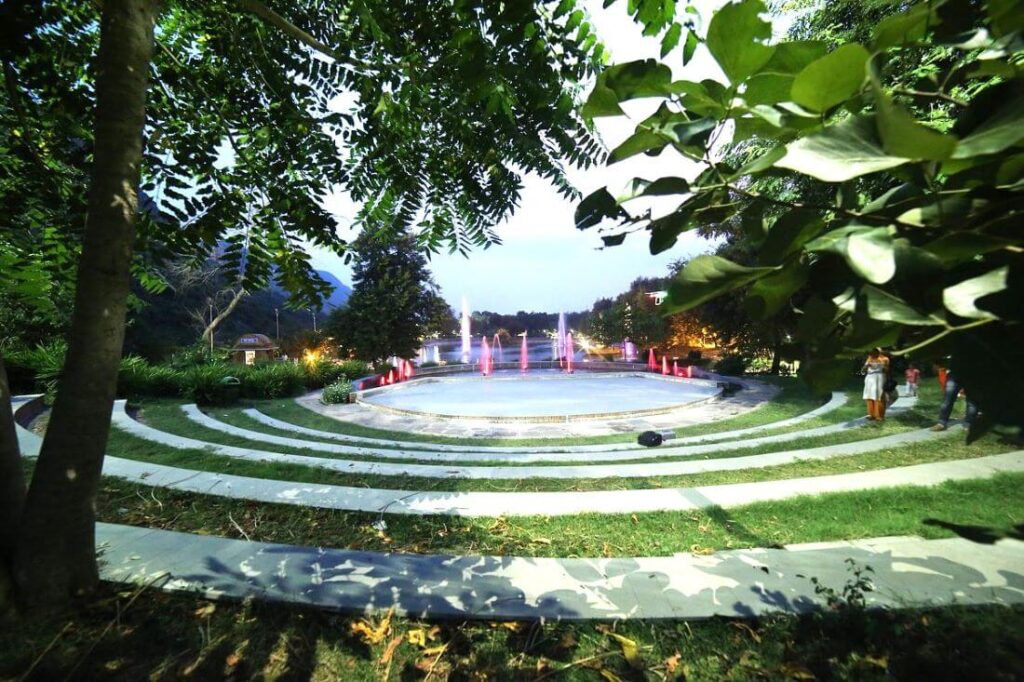
Pandupokhar is a tranquil pond in Rajgir, surrounded by lush greenery and serene natural landscapes. Its calm waters and peaceful environment make it an ideal spot for quiet reflection and relaxation away from the city’s bustle.
The site is steeped in mythology, with legends linking it to the Pandavas from the Mahabharata, who are believed to have visited this place during their exile. This adds a layer of historical and cultural significance to the location, attracting both devotees and history enthusiasts.
Visitors to Pandupokhar often enjoy nature photography, meditation, or simply walking along the pond’s edge. Its serene ambiance, combined with the mythological stories, makes it a perfect destination for those seeking a blend of natural beauty and cultural heritage in Rajgir.
15. Ghora-Katorah Eco Park
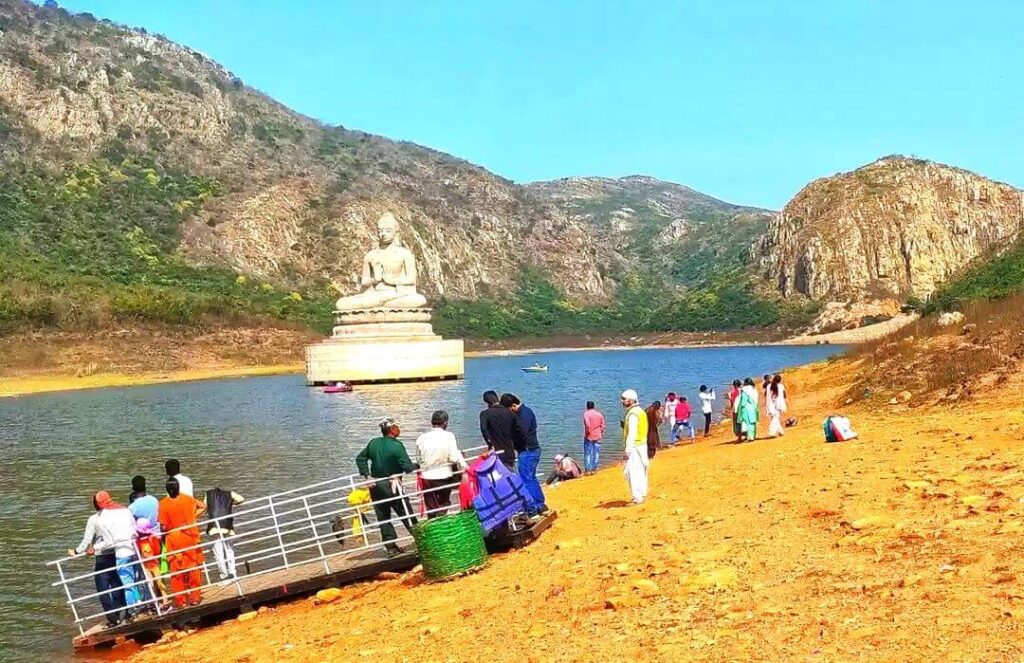
Ghora-Katorah Eco Park in Rajgir is a beautiful destination that promotes sustainable and eco-friendly tourism. Nestled amidst rolling hills, the park offers visitors a chance to connect with nature while enjoying environmentally responsible recreational activities.
The park features well-maintained walking trails and viewpoints, allowing visitors to explore the scenic landscapes at their own pace. From these vantage points, one can enjoy panoramic views of Rajgir’s hills, valleys, and surrounding greenery, making it a photographer’s paradise.
In addition to sightseeing, Ghora-Katorah Eco Park provides opportunities for eco-friendly activities that are both educational and enjoyable. Families, nature lovers, and adventure enthusiasts can spend time here learning about local flora and fauna while experiencing the serene beauty of Rajgir in a sustainable way.
Travel Tips for Visiting Rajgir
- Best Time to Visit: October to March, when the weather is pleasant for trekking and sightseeing.
- Accommodation: Rajgir offers a range of hotels and guesthouses near key attractions and hills.
- Local Transport: Auto-rickshaws, taxis, and local buses are convenient for short distances. Ropeways provide easy access to Ratnagiri and other hills.
- Food: Don’t miss local Bihari cuisine, including litti-chokha, sattu paratha, and regional sweets.
Conclusion
Rajgir is more than just a tourist destination; it is a journey into India’s spiritual, historical, and natural heritage. From the tranquil bamboo groves of Venuvan to the majestic Vishwa Shanti Stupa, from ancient Jain temples to the serene meditation caves, every corner of Rajgir tells a story. Whether you are seeking spiritual growth, historical exploration, or adventure amidst nature, Rajgir promises an unforgettable experience.

